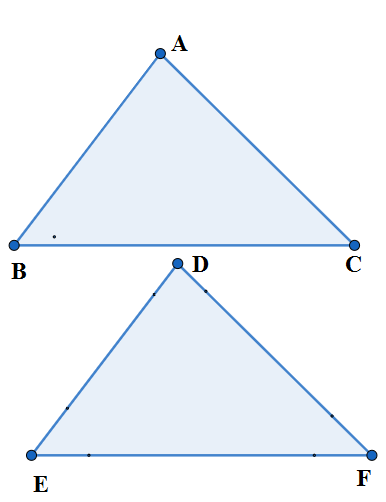
If the area of two similar triangles is equal, prove that they are congruent. \[\]
Answer
554.7k+ views
Hint: We take two similar triangles $ \Delta ABC\sim \Delta DEF $ and where ratios of sides are $ \dfrac{AB}{DE}=\dfrac{BC}{EF}=\dfrac{AC}{DF} $ . We use the theorem that the ratio of areas of two similar triangles is equal to the squared ratio of corresponding sides to prove $ AB=DE, BC=EF, AC=DF $ which means the triangles are congruent. \[\]
Complete step by step answer:

Let us take two similar triangles $ \Delta ABC\sim \Delta DEF $ . We know that in similar triangles the measures of corresponding angles are equal and the sides opposite to them are called corresponding sides. The ratios of corresponding sides are equal. So let us take $ \angle A=\angle D,\angle B=\angle E,\angle C=\angle F $ and have the ratios of corresponding sides
\[\dfrac{AB}{DE}=\dfrac{BC}{EF}=\dfrac{AC}{DF}\]
We know the theorem that if two triangles are similar, then the ratio of the area of both triangles is proportional to the square of the ratio of their corresponding sides. So we have
\[\dfrac{\text{Area of }\Delta \text{ABC}}{\text{Area of }\Delta DEF}={{\left( \dfrac{AB}{DE} \right)}^{2}}={{\left( \dfrac{BC}{EF} \right)}^{2}}={{\left( \dfrac{AC}{DF} \right)}^{2}}\]
We are given in the question that $ \text{Area of }\Delta \text{ABC}=\text{Area of }\Delta DEF $ . So we have;
\[\begin{align}
& \Rightarrow \dfrac{\text{Area of }\Delta \text{ABC}}{\text{Area of }\Delta \text{ABC}}={{\left( \dfrac{AB}{DE} \right)}^{2}}={{\left( \dfrac{BC}{EF} \right)}^{2}}={{\left( \dfrac{AC}{DF} \right)}^{2}} \\
& \Rightarrow 1={{\left( \dfrac{AB}{DE} \right)}^{2}}={{\left( \dfrac{BC}{EF} \right)}^{2}}={{\left( \dfrac{AC}{DF} \right)}^{2}} \\
\end{align}\]
Let us consider
\[1={{\left( \dfrac{AB}{DE} \right)}^{2}}\]
We take square root both sides to have
\[\begin{align}
& \Rightarrow 1=\dfrac{AB}{DE} \\
& \Rightarrow AB=DE.......\left( 1 \right) \\
\end{align}\]
Similarly we consider
\[1={{\left( \dfrac{BC}{EF} \right)}^{2}}\]
We take square root both sides to have
\[\begin{align}
& \Rightarrow 1=\dfrac{BC}{EF} \\
& \Rightarrow BC=EF.......\left( 2 \right) \\
\end{align}\]
Similarly we consider
\[1={{\left( \dfrac{AC}{DF} \right)}^{2}}\]
We take square root both sides to have
\[\begin{align}
& \Rightarrow 1=\dfrac{AC}{DF} \\
& \Rightarrow AC=DF.......\left( 3 \right) \\
\end{align}\]
We conclude from equations (1), (2) and (3) that
\[AB=DE,BC=EF,AC=DF\]
Since the lengths of the corresponding sides of the triangles are equal by side-side-side criteria the triangles are congruent which means $ \Delta ABC\cong \Delta DEF $ . Hence the statement is proved. \[\]
Note:
We note that all congruent triangles are similar but not all similar triangles are congruent and both for similar and congruent triangles the measures of corresponding triangles are equal. We also note the length of sides is always positive and hence we have rejected the negative square root here.
Complete step by step answer:

Let us take two similar triangles $ \Delta ABC\sim \Delta DEF $ . We know that in similar triangles the measures of corresponding angles are equal and the sides opposite to them are called corresponding sides. The ratios of corresponding sides are equal. So let us take $ \angle A=\angle D,\angle B=\angle E,\angle C=\angle F $ and have the ratios of corresponding sides
\[\dfrac{AB}{DE}=\dfrac{BC}{EF}=\dfrac{AC}{DF}\]
We know the theorem that if two triangles are similar, then the ratio of the area of both triangles is proportional to the square of the ratio of their corresponding sides. So we have
\[\dfrac{\text{Area of }\Delta \text{ABC}}{\text{Area of }\Delta DEF}={{\left( \dfrac{AB}{DE} \right)}^{2}}={{\left( \dfrac{BC}{EF} \right)}^{2}}={{\left( \dfrac{AC}{DF} \right)}^{2}}\]
We are given in the question that $ \text{Area of }\Delta \text{ABC}=\text{Area of }\Delta DEF $ . So we have;
\[\begin{align}
& \Rightarrow \dfrac{\text{Area of }\Delta \text{ABC}}{\text{Area of }\Delta \text{ABC}}={{\left( \dfrac{AB}{DE} \right)}^{2}}={{\left( \dfrac{BC}{EF} \right)}^{2}}={{\left( \dfrac{AC}{DF} \right)}^{2}} \\
& \Rightarrow 1={{\left( \dfrac{AB}{DE} \right)}^{2}}={{\left( \dfrac{BC}{EF} \right)}^{2}}={{\left( \dfrac{AC}{DF} \right)}^{2}} \\
\end{align}\]
Let us consider
\[1={{\left( \dfrac{AB}{DE} \right)}^{2}}\]
We take square root both sides to have
\[\begin{align}
& \Rightarrow 1=\dfrac{AB}{DE} \\
& \Rightarrow AB=DE.......\left( 1 \right) \\
\end{align}\]
Similarly we consider
\[1={{\left( \dfrac{BC}{EF} \right)}^{2}}\]
We take square root both sides to have
\[\begin{align}
& \Rightarrow 1=\dfrac{BC}{EF} \\
& \Rightarrow BC=EF.......\left( 2 \right) \\
\end{align}\]
Similarly we consider
\[1={{\left( \dfrac{AC}{DF} \right)}^{2}}\]
We take square root both sides to have
\[\begin{align}
& \Rightarrow 1=\dfrac{AC}{DF} \\
& \Rightarrow AC=DF.......\left( 3 \right) \\
\end{align}\]
We conclude from equations (1), (2) and (3) that
\[AB=DE,BC=EF,AC=DF\]
Since the lengths of the corresponding sides of the triangles are equal by side-side-side criteria the triangles are congruent which means $ \Delta ABC\cong \Delta DEF $ . Hence the statement is proved. \[\]
Note:
We note that all congruent triangles are similar but not all similar triangles are congruent and both for similar and congruent triangles the measures of corresponding triangles are equal. We also note the length of sides is always positive and hence we have rejected the negative square root here.
Recently Updated Pages
Two men on either side of the cliff 90m height observe class 10 maths CBSE

What happens to glucose which enters nephron along class 10 biology CBSE

Cutting of the Chinese melon means A The business and class 10 social science CBSE

Write a dialogue with at least ten utterances between class 10 english CBSE

Show an aquatic food chain using the following organisms class 10 biology CBSE

A circle is inscribed in an equilateral triangle and class 10 maths CBSE

Trending doubts
Why is there a time difference of about 5 hours between class 10 social science CBSE

Write a letter to the principal requesting him to grant class 10 english CBSE

What is the median of the first 10 natural numbers class 10 maths CBSE

The Equation xxx + 2 is Satisfied when x is Equal to Class 10 Maths

Which of the following does not have a fundamental class 10 physics CBSE

State and prove converse of BPT Basic Proportionality class 10 maths CBSE




